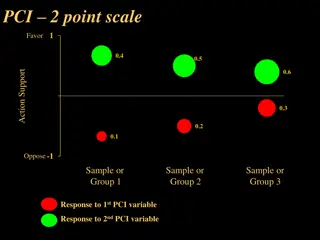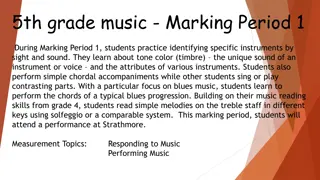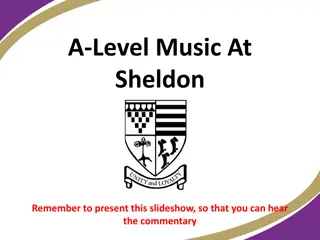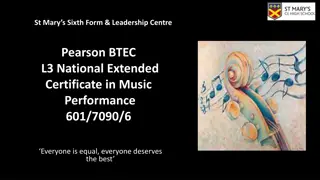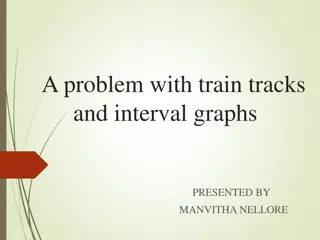Essential Music Theory: Scales, Arpeggios, and Interval Practice
Dive into the fundamentals of music theory with a focus on scales, arpeggios, and interval training. Understand Major and Minor scale structures, learn to play arpeggios, and enhance your musical ear for better performance. Explore the importance of regular scale practice in mastering different music compositions.
Download Presentation

Please find below an Image/Link to download the presentation.
The content on the website is provided AS IS for your information and personal use only. It may not be sold, licensed, or shared on other websites without obtaining consent from the author.If you encounter any issues during the download, it is possible that the publisher has removed the file from their server.
You are allowed to download the files provided on this website for personal or commercial use, subject to the condition that they are used lawfully. All files are the property of their respective owners.
The content on the website is provided AS IS for your information and personal use only. It may not be sold, licensed, or shared on other websites without obtaining consent from the author.
E N D
Presentation Transcript
Arnon Hosakulsuwan Link : http://pws.npru.ac.th/arnon
BRASS II LEARNING MANAGEMENT SYSTEM Arnon Hosakulsuwan Link : http://pws.npru.ac.th/arnon
Chapter 2 Scales and Arpeggios Major Scale Minor Scale Arpeggios Arnon Hosakulsuwan Link : http://pws.npru.ac.th/arnon
Important things Every music, the composer has written from structure of scale, if the performer has practice scale on every keys already, it s make the performer easily to play on every music. performer practice scales often, your ears will memorize the interval between the notes. And scales can make your ears better, because when the Arnon Hosakulsuwan Link : http://pws.npru.ac.th/arnon
Major Scale The structure of Major scale, the interval between notes is not same, some step is 2nd major interval and some step is 2nd minor interval. Example, C major scale structure. (W is whole, H is half) 1 2 is Whole step, 2 3 is Whole step, 3 4 is half step, 4 5 is Whole step, 5 6 is Whole step, 6 7 is Whole step and 7 8(1) is half step. Arnon Hosakulsuwan Link : http://pws.npru.ac.th/arnon
Minor scale The structure of Minor scale, the interval between notes is not same, some step is 2nd major interval and some step is 2nd minor interval. Example, A minor scale structure. (W is whole, H is half) 1 2 is Whole step, 2 3 is half step, 3 4 is Whole step, 4 5 is Whole step, 5 6 is half step, 6 7 is Whole step and 7 8(1) is Whole step. Arnon Hosakulsuwan Link : http://pws.npru.ac.th/arnon
Arpeggios Arpeggios is an interval of scale the structure is 1st 3rd 5th and 8th from the scale. Example, C arpeggios. And play only 1,3,5 and 8 Arnon Hosakulsuwan Link : http://pws.npru.ac.th/arnon
Arnon Hosakulsuwan Link : http://pws.npru.ac.th/arnon
Arnon Hosakulsuwan Link : http://pws.npru.ac.th/arnon







